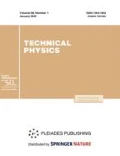Abstract
A continuum mathematical model of low-concentration suspension transfer without mixing in a plane vertical gravitational classifier under conditions of phase flux balance is suggested. The flow of a carrier medium is assumed to be laminar, and no limitations on the particle sedimentation rate are imposed. Analytical relationships to calculate the local counting functions of the particle size distribution density have been derived. A computational experiment has confirmed the fractionation of a monodisperse suspension and the presence of fine particles in the “heavy” fractions of polydisperse suspensions. The latter fact is explained by a low velocity of the disperse medium at the “wetted” surfaces of the hydroclassifier. The results are in agreement with available experimental data and data calculated in terms of classical kinetic models.







Similar content being viewed by others
REFERENCES
A. Affa, S. A. Razzak, K. D. Nigam, and J.-X. Zhu, Ind. Eng. Chem. Res. 49 (9), 7876 (2009).
R. R. Polchar and V. Shilapurain, Particuology 31, 59 (2017).
M. D. Barsky, V. I. Revnivtsev, and Yu. V. Sokolkin, Gravitational Classification of Granular Materials (Nedra, Moscow, 1974) [in Russian].
A. M. Goula, M. Kostoglu, T. D. Karapatsios, and A. L. Zouboulis, Chem. Eng. J. 140, 110 (2007).
J. B. Farrow, P. D. Fawell, R. R. M. Johnston, T. B. Nguyen, M. Rudman, K. Simic, and J. D. Swift, Chem. Eng. J. 180, 149 (2000).
Y. Cheng and J.-X. Zhu, Can. J. Chem. Eng. 83 (2), 177 (2005).
D. I. Chirkun, N. P. Saevich, A. E. Levdanskiy, and S. V. Yarmol’nik, Tr. Belorus. Gos. Tekhnol. Univ. (BGTU), Ser. 2: Khim. Tekhnol., Biotekhnol., Geoekol., No. 2, 190 (2017).
A. Di Renzo, F. D. Cello, and F. P. Maio, Chem. Eng. Sci. 66 (13), 2945 (2011).
M. Yongli, L. Mingyan, and Z. Yuan, Chem. Eng. Sci. 66 (13), 2945 (2011).
H. Nasr-El-Din, J. H. Masliyah, K. Nandakumar, and D. H.-S. Law, Chem. Eng. Sci. 43 (12), 3225 (1988).
Y. Berman and A. Tamir, Chem. Eng. Sci. 58, 2089 (2003).
G. M. Ostrovsky, Applied Mechanics of Inhomogeneous Media (Nauka, St. Petersburg, 2000) [in Russian].
T. T. Lugumanov and V. S. Kuleshov, Tr. Mavlyutov Inst. Mekh. 10, 66 (2014).
G. Serge and A. Silberberg, Nature 189, 209 (1961).
P. G. Saffman, J. Fluid Mech. 22, 385 (1965).
V. P. Yatsenko, Fiz. Aerodispers. Sistem 39, 240 (2002).
D. A. Gubaydullin and P. P. Osipov, Current Problems of Continuum Mechanics. To Mark the 20th Anniversary of Inst. Mekh. Mashinisrtoen. Kazan Sci. Center RAN (Foliant, Kazan, 2011), Vol. 1, pp. 82–97 [in Russian].
R. B. Bird, W. E. Stewart, and E. N. Lightfoot, Transport Phenomena (Wiley, New York, 1960).
Yu. I. Dytnersky, Processes and Devices of Chemical Technology (Khimiya, Moscow, 2002), Chap. 1 [in Russian].
G. Korn and T. Korn, Mathematical Handbook for Scientists and Engineers. Definitions, Theorems and Formulas for Reference and Review (McGraw-Hill, 1967).
F. D. T. Luna, A. G. Silva, N. K. Fukumasu, O. Bazan, J. H. A. Gouveia, D. Moraes, Jr., J. I. Yanagihara, and A. S. Vianna, Jr., Chem. Eng. J. 362, 712 (2019).
I. V. Domansky, I. V. Davydov, and V. P. Borovinsky, Tsvet. Metally, No. 1, 25 (2000).
A. G. Gael’ and L. F. Smirnova, Sands and Sandy Soils (GEOS, Moscow, 1999) [in Russian].
New Handbook of Chemist and Technologist. Processes and Devices of Chemical Technologies (NPO Professional, St. Petersburg, 2006), Part 2 [in Russian].
Author information
Authors and Affiliations
Corresponding author
Ethics declarations
The author declares that he has no conflicts of interest.
Additional information
Translated by V. Isaakyan
Rights and permissions
About this article
Cite this article
Ryazhskikh, A.V. Mathematical Model of Low-Concentration Disperse Suspension Fractionation in a Plane Vertical Hydroclassifier. Tech. Phys. 65, 1226–1232 (2020). https://doi.org/10.1134/S1063784220080150
Received:
Revised:
Accepted:
Published:
Issue Date:
DOI: https://doi.org/10.1134/S1063784220080150




